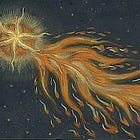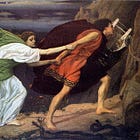“Prose poetry is a monster-child of two incompatible impulses, one which wants to tell a story and another, equally powerful, which wants to freeze an image, or a bit of language, for our scrutiny.” — Charles Simic, "Essay on the Prose Poem”
This is the first part of a brief prose poetry exploration. These prose poetry posts are informal supplements to the Synthesis Series, where I take a collection of excerpts and extract the lessons we should apply to writing poetry. Prose poems, despite their deceptively straightforward appearance, contain highly fragmented and disconnected components. How do we connect these components under an overarching theme?
Today, we read “Forsythia” by Ada Limón, the current United States Poet Laureate.
Prose Poetry Readings
“Forsythia” by Ada Limón
“Mausoleum” by Terrance Hayes from Wind in a Box
“On Walking Backwards” by Anne Carson from Short Talks
Prose Poetry Analyses
“Forsythia” by Ada Limón from The Hurting Kind
Limón is one of my favorite poets, and “Forsythia” is one of my favorite Limón poems. Though “Forsythia” initially appears to discuss grief, the poem is not single-minded. In fact, I recently referenced it in a school presentation on the topic of community. Indeed, there are at least three unspoken relationships blossoming throughout the paragraph: the towhee and the forsythia, the speaker and her stepmother Cynthia, and the speaker and the man with whom she is speaking.
Limón incorporates several clever literary techniques in this poem. Most notably, “forsythia” is a near-homophone with “for Cynthia,” framing the title of the poem as a dedication “for Cynthia.” Moreover, Limón uses the devices of connotation and juxtaposition copiously. “Yellow” connotes happiness, and, contrasted against the deepening “night,” Limón juxtaposes survival with death, strength with grief…
An excellent indicator that I have read good poetry is my desire to reread the poem and parse through its many interpretations. Despite the short length of “Forsythia,” Limón introduces universal seeds of truth, which inevitably sprout into different plants for each reader. In typical Limón fashion (see “Stillwater Cove” by Limón for another masterful demonstration of this technique), Limón uses a specific natural event to refer to a greater truth. Here, these aspects are interwoven seamlessly. She begins by placing us “at the cabin in Snug Hollow near McSwain Branch creek.” This setting does not evoke emotion in the reader; instead, as poets frequently do, Limón is granting the poem its gravitas, specificity, and realism. In the following sentence, we are transported out of reality and into quasi-philosophical pondering: “we carry so many people with us wherever we go.” Immediately thereafter, returning to grounded specificity, we “[expect] to hear an owl.” While the poem follows a narrative structure, the speaker switches between the mundane and the profound, creating the whiplash that is characteristic of prose poetry.
In prose poetry, the poet has the liberty to make remarkable leaps from sentence to sentence, which lends these poems their poetic aspect. After all, prose poems cannot rely on line breaks for enjambment. In prose, such disjoined lines are inappropriate.
In an interview with Anastasia Nikolis, Limón speaks further about the form of prose poetry:
“A poem doesn’t have to have line breaks to do the work of revealing; what it does have to do is expose life in a new way, unearth a larger thing through one small moment. A reader only needs to know that the biggest difference between a lineated poem and a prose poem is pacing. The prose poem moves faster. It doesn’t have the line breaks to slow it down so it’s supposed to read like you’d read any piece of prose. The speed allows for a sort of surreality to take place, for the pressure cooker to get turned up.” — Ada Limón, “From the Archive: An Interview with Ada Limón”
Indeed, “Forsythia” reads as a sort of “pressure cooker.” On one hand, the piece seems tranquil and understated—we are positioned “lying” “in a soft silence,” and we are dealing with an absence as we explore the speaker’s grief.
However, the piece also carries a sense of abundance. It is not that the towhee is out but that “all the animals are out;” we do not spend an hour in nature but “all afternoon;” and the forsythia is not blooming but “spilling out into the horizon.” Cynthia’s dying words are “more yellow,” and the speaker echoes this sentiment. The phrase “more yellow” appears four times throughout the poem! Here, abundance leans into the territory of exaggeration. To exaggerate is to lie, a form of self-deception masked as self-comfort.
After the poem’s crescendo—”For Cynthia, for Cynthia, forsythia, forsythia, more yellow”—the speaker crashes into a final silence: “It is night now. And the owl never comes, only more of night and what repeats in the night.” What a curious, haunting ending.
The syntax of “what repeats in the night” forms both a sentence and a question—“what repeats in the night?” It is as if the speaker has been fending off her grief with a furious abundance of good, just as the towhee “furiously builds her nest in the untamed forsythia,” and has finally succumbed to “what repeats in the night.” What has been repeated? Yes, the phrase “more yellow.” This is what repeats all afternoon: ”more yellow.” The day is life is yellow is a tribute to the dead; the night is death is dark is a confession—that grief is temporary but unending, that grief is cyclical.




